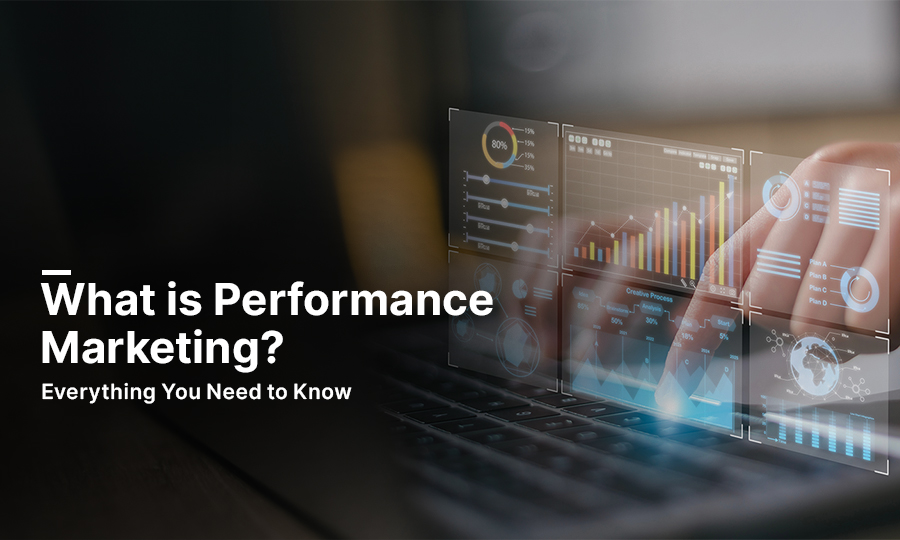Marketing and advertising- both go hand in hand in this ever-evolving digital landscape. But if you are looking for a secret weapon that could be less risky and more cost-effective, then performance marketing is at your disposal.
Performance marketing is ideal for those companies who want to reach their targeted audience at scale. This is because here advertisers only pay marketing providers when specific actions have been taken or when their business objectives have been met.
So, if you are thinking about fine-tuning your marketing performance to improve your digital presence at a reasonable price, then check out this blog till the end!
Here you will get to know more about what is performance marketing, its benefits, how it’s different from traditional marketing, some of its best practices, strategies, and more.
What is Performance Marketing?
Performance marketing is the term referring to any digital marketing strategy that focuses on a results-driven approach and attributes to any specific outcome. This marketing activity can be easily tracked and measured depending on specific actions like – sales, clicks, leads, or any other action-based customer behaviours.
As the term suggests, performance marketing’ is mainly based on the performance-based outcome of any marketing campaign. It is one of the most effective ways to get the highest return on investment and maximise results from your online spending.
As conversion strategy and customer engagement are two chief cornerstones of any performance marketing campaign, it is currently in vogue. It provides more power to the advertisers by ensuring that they are spending their budget only on successful marketing campaigns.
There are various channels depending on your performance marketing functions. These are- social media advertising, pay-per-click (PPC) advertising, search engine marketing (SEM), and affiliate marketing.
Key Benefits of Performance Marketing for Your Business

Like digital marketing, performance marketing is also growing at a significant rate. This is because according to a study it has been found that only a few of the marketers are satisfied with their conversion rates. So, businesses are using this online marketing strategy effectively to drive more results and generate more sales.
With a performance marketing campaign, you only need to pay for the results that you have got, so it allows you to allocate your marketing budget accordingly. Some other key benefits of performance marketing include the following:
- Easily Trackable and Measurable
The effectiveness of the performance marketing campaigns can be easily measured using some key metrics like cost per acquisition, click-through rates, and conversion rates. These metrics allow you to track the performance of your advertising campaign at a granular level.
Thus, it provides marketers with some detailed data and insights based on which they can optimize the campaigns and improve their results.
- Diversified Ways of Reaching an Audience
Performance marketing allows you to expand your reach in diversified ways. You can go beyond your general streams of revenue and traditional sales channels to reach new audiences. Like, you can partner with some influencers and affiliates associated with your industry, etc.
It allows you to make your business discoverable in your niche market in various organic ways. Also, it can lead to long-term relationships.
- Allows More Targeted Reach
It allows you to fine-tune your campaigns in a number of ways to fulfil specific goals. This includes targeting specific audiences of a specific region.
By enhancing your campaign’s targeted reach, you can ensure to make your ads visible to the right audiences at the right time. So, your target audience can be easily attracted to your site.
- Much More Efficient
With performance marketing, you can grow your business in a quite low-risk way. You can create unique contents and campaigns that seamlessly resonate with your niche audience. This strategy seems to be more effective than other marketing strategies in the sense that if your business doesn’t get results, you don’t need to pay or invest in it.
- Quite Flexible and Budget-friendly
Performance marketing strategies are quite flexible to adjust, especially when it comes to making any pivotal changes in it. So, without putting much effort, you can easily alternate your strategies according to your business needs.
Running this marketing campaign is also quite budget-friendly, as here you pay only when any action takes place like leads or clicks. It allows you to spend quite wisely in comparison to PPC or CPC.
Performance Marketing vs. Traditional Marketing
Both traditional and performance marketing have their value in the marketing domain, but they differ from each other a lot. On the one hand, traditional marketing involves the promotion of any services through conventional media like newspaper ads, TV or radio.
On the other hand, performance marketing not just promotes but focuses on bringing in more conversions to your site.
Key Differences Between Them
Whether you choose traditional or performance marketing for your business, each one of them comes with its own set of challenges and effectiveness. You can implement any of these marketing tactics, however, if you want a desired result, then choose based on your target audience’s behaviour, business goals and budget.
Let’s take a closer look at how these two marketing types are distinct from each other.
| Features | Traditional Marketing | Performance Marketing |
| Capability of Targeting Audiences | Targets a broader range of audience depending on general demographics | Targets with more precision based on their online behaviour and interests. |
| Cost-effectiveness | Requires much more invetsment | Much more cost-effective approach |
| Engagement with Audiences | Much more passive engagement with audiences | Involves direct interaction with audiences |
| Measurability | Measures reach through traditional metrics like circulation, etc. | Offers more detailed analytics for measurable outcomes |
| Focusses on | Brand recall and recognition | Building long-term customer loyalty |
| Adapatability | Less adaptable to changes | Highly adapatable as campaigns can be tweaked based on real-time data analysis. |
| Responsiveness | Preferable for those who follows traditional media | Preferable for audiences engaged with digital channels |
Advantages of Performance Marketing Over Traditional Marketing
What makes performance marketing a more attractive option for businesses over traditional marketing is that it aims to increase your business’s ROI. Some other key benefits of performance marketing include the following:
- Cost-Effectiveness
Performance marketing is based on a pay-for-performance model, so here the advertisers need to only pay when any specific action is completed, be it a sale, click or lead generation. Contrary to this, in traditional marketing, the advertisers need to pay upfront, irrespective of the outcome.
The former one allows businesses to allocate their marketing budget in a more effective way and thus it reduces wastage on strategies that prove ineffective.
- Targeted Advertising
According to research conducted by Instapage, it has been found that 76% of consumers expect personalized experiences from the company. Performance marketing does so! It focuses on working with precision; therefore, it allows businesses to reach their specific audiences based on their interests, behaviour, demographics, and other factors.
Unlike traditional or brand marketing, the targeted approach of performance marketing ensures the fact their ads are directed towards the most relevant audience. Thus, it results in improved conversion and engagement.
- Enhanced Transparency
Contrary to traditional marketing, performance marketing offers much greater transparency in terms of campaign performance and costs. Thus, it allows the advertisers to gain full visibility on where they are spending their dollars and what results they are achieving through it.
- Measurable Outcome
Unlike traditional marketing whose results are difficult to track, performance marketing campaigns allow businesses to track the success of their marketing efforts in real time. It allows marketers to track metrics like sales, conversions, clicks and ROI.
This also enables them to make data-driven decision-making and optimize campaign performance accordingly for better outcomes.
- Risk Mitigation
In traditional advertising campaigns, there is no guarantee of return on investment. In performance marketing, as advertisers need to only pay for the actual results, it assists the marketing companies by mitigating the risks associated with traditional marketing.
So, this makes it a wiser option for those businesses that possess uncertain market conditions or limited budgets.
- Flexibility and Scalability
Based on the real-time performance data, performance marketing campaigns can be seamlessly adjusted and optimized. Thus, the flexibility and scalability of performance campaigns allow advertisers to drive more conversions and reach larger audiences. So, it results in maximized results.
In a nutshell, it is seen that performance marketing seems to be a preferred choice for businesses that want to maximize their return on investment.
Top Performance Marketing Channels Used Often
With the aim of reaching and engaging with their target audience and driving measurable results, performance marketing utilizes various channels. Each of these channels comes with its unique advantages and can be tailored to specific audience preferences and campaign objectives.
Check out some popular choices that are used often:
- Social Media Advertising

With billions of active users on social media platforms like Facebook, Instagram, LinkedIn, Pinterest, etc., it becomes easier for brands to tap into their potential customers. But even to use this channel efficiently, brands need to identify which will be the right platform where they will be able to get their target audience.
Like, Pinterest is for shoppers with specific interests, and LinkedIn is for working professionals. However, if you need a wider and more diverse audience, then you can tap into Facebook and Instagram. Marketers can seamlessly create engaging content or run targeted ads on these platforms in order to reach their target audiences.
Through social media channels, they can also foster meaningful interactions with their audiences and thus drive more website traffic, conversions, and brand awareness. In order to measure the performance of marketing through this channel, you can check out metrics like shares, comments, clicks, engagement, likes and sales.
- Native Advertising
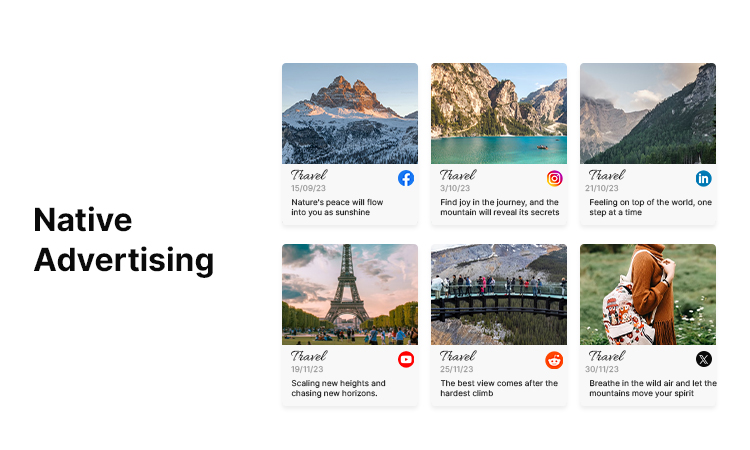
Native advertising, though an ad, doesn’t seem like an ad. It involves designing content in a manner where you get a high degree of control over what is being published in the medium.
In native advertising, the promotional content is well integrated with the user experience of the specific platform to make the content more engaging and less intrusive. Whether it’s promotional posts on social media feeds or sponsored articles on news websites, these native ads match the functionality and form of the platform.
Mostly, this channel is preferred during retargeting marketing. It provides potential clients with some valuable information and increases their affinity to perform any specific action. This also leads to an increase in customer loyalty.
Some common metrics that can be used for measuring specifically these advertisements include pay-per-click or pay-per-impression.
- Search Engine Marketing
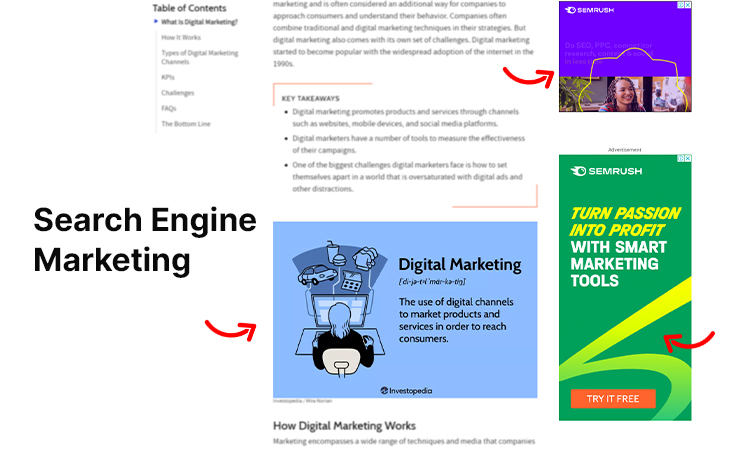
Search engine marketing, also known as paid search marketing, refers to advertising campaigns that are being run to drive traffic from search engines like Google. Here the advertiser needs to pay for the number of clicks that their advertisements get on Yahoo, Bing, and Google.
So, performance marketers who use this channel need to conduct proper research and find the correct keywords for their campaign. Based on these keywords, the campaign’s performance will be ensured.
Some popular platforms that allow advertisers to run SEM campaigns and reach those users who are actively looking for your products and services are Google Ads and Bing Ads.
- Affiliate Marketing
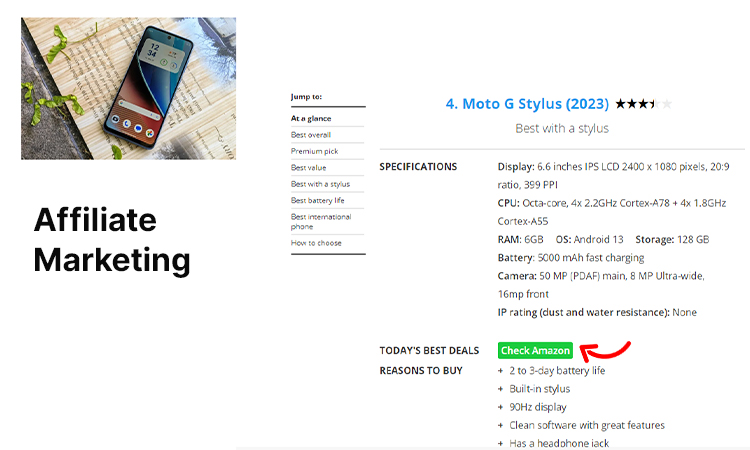
In affiliate marketing, an affiliate partner promotes the advertiser to their audience by using a code or link. In fact, they get paid as a commission on the basis of their conversions from their unique link.
Affiliate marketing involves partnerships with affiliates in the form of influencers, publishers, and other businesses to promote their services and products in exchange for leads generated through referrals.
In this online marketing, the affiliates get a commission for every lead, click or sale generated through the links on their site. From local businesses to global brands, every affiliate marketer takes advantage of this channel for performance-based advertising.
- Sponsored Content

Sponsored content refers to paid promotional articles or posts that are published on different online platforms in exchange for payment. When a marketer decides to use this channel for performance marketing, it involves working with various influencers, content curation sites and prominent figures.
Sponsored content can be available in the form of podcasts, videos, articles, and much more. These contents are designed specifically to provide value to the target audience while promoting any product or service.
Due to a rise in the number of influencers and content curation sites, this channel is on the trend. People on these channels are becoming followers and subscribers, and deeply following their sponsored recommendations.
- Pay-Per-Click Advertising
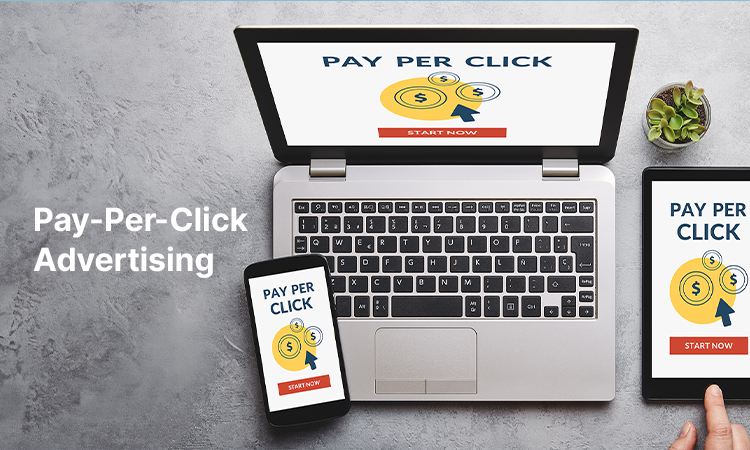
PPC advertising is a performance-based marketing tactic where the advertisers need to pay a certain fee every time when their ad gets clicked. It allows advertisers to bid on any specific keywords that they want to target by making their appearance in their ads in the search engine results.
Therefore, when a user looks for those specific keywords, the advertiser’s ads appear at the top of the search results. Advertisers make use of this channel to reach their targeted audience quickly based on specific locations, interests, and demographics.
Some of the most common platforms that offer these PPC solutions include Google Adwords, Bing Ads, YouTube Ads, Instagram Ads, Facebook Ads, etc. Among all these pay-per-click advertising channels, Google Ads reigns superior due to its unmatched global popularity.
Advertisers can make use of these platforms for creating different types of ads like display ads, video ads, product ads, shopping ads, search ads, etc., and target their audience more precisely.
- Email Marketing
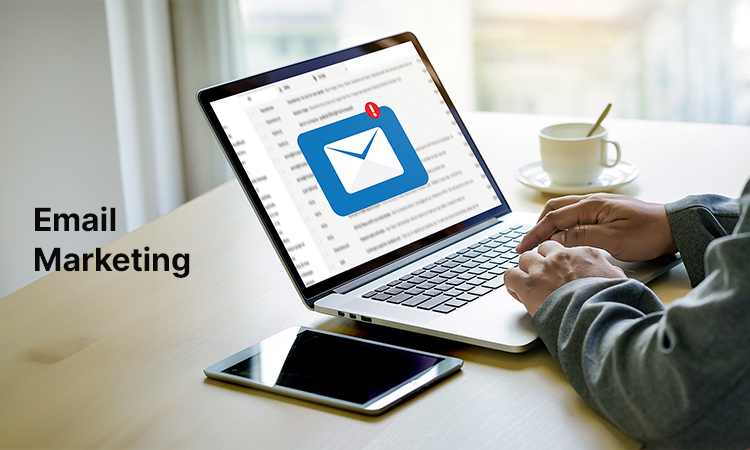
This form of performance marketing involves advertisers targeting their potential audience by sending emails. It basically focuses on generating quantifiable results like sales, leads or conversions for your business. Here the advertisers directly establish a partnership with publishers and develop an audience that perfectly aligns with their target market.
Publishers, then on behalf of their advertisers, send out promotional emails and earn commissions for every action that their subscribers take. Leveraging this strategy ensures that your message reaches the right audience at the right time.
Tips on Creating Effective Performance Marketing Campaigns
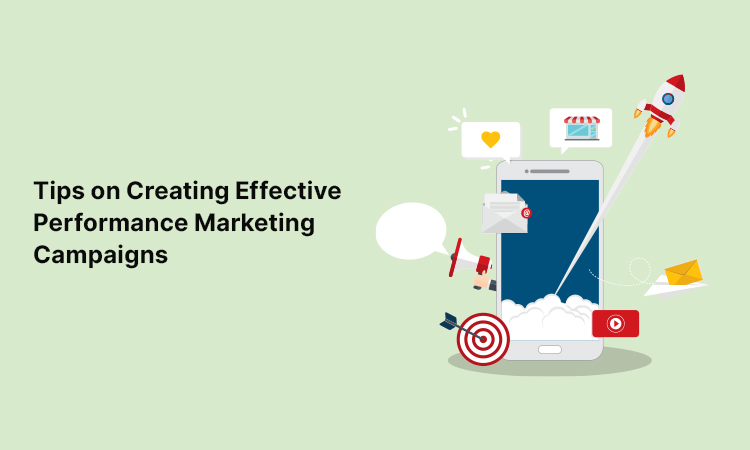
Crafting high-impact performance marketing campaigns is not a cakewalk. It can often be exhilarating and daunting at the same time especially considering the constantly-changing digital landscape.
So, if you are embarking on a journey to creating effective campaigns for performance marketing, then it requires careful planning, a sound understanding of your target audience’s behaviour and their strategic thinking.
Want some effective tips on it that really works? Check out the below mentioned tips that can assist you with creating campaigns for your business to unlock its full potential.
- Set Clear Goals for Your Campaign
Before you undertake any performance marketing campaign, it is better to set a clear and realistic goal for your campaign. You must clearly define what you want to achieve with your campaign.
This can be any specific measurable goals like- generating leads, increasing website traffic by 40%, raising brand awareness, increasing sales by 50%, improving customer engagement, etc.
By setting these goals, it becomes easier for you to track your progress along the way.
- Get to Know Your Target Audience
For any campaign, it is crucial to identify your target audience and segment them on the basis of different stages of the marketing funnel. Getting to know your target audience will help in understanding their preferences, interests, demographics, and behaviour. This will also effectively help in crafting effective and personalized marketing messages.
You can get an insight into your target audience by conducting thorough market research, analyzing your customer data, and creating buyer personas. Once you get to know who your target audience is, try to segment them at different stages.
Like, those who are at the top of the marketing funnel, they are at the awareness stage. For them, you can create educational content. However, in order to target prospects who are at the bottom of the funnel, you can create persuasive content like testimonials and case studies. This will help them in making that final decision.
When you segment your audience, it becomes easier for you to tailor your performance marketing campaigns accordingly. Thus, it increases the chances of your campaign’s success as it aligns with the preferences and unique needs of each prospect.
- Make the Best Use of Different Performance Marketing Channels
In a performance marketing campaign, it is significant to pick the right channel as per your campaign goals and target audience. If you choose the wrong channel incidentally, then you won’t get to see any results.
So, you need to analyze your target audience’s behaviour and accordingly look for the marketing channels where their potential customers spend most of the time. You can explore various performance marketing channels like content marketing, search engine optimization (SEO), email marketing, social media optimization, pay-per-click advertising (PPC), etc.
From here, you can choose the one that aligns best with your marketing goals. Like, with the arrival of TikTok, the platform in the year 2023 has managed to gather over 1.9 billion worldwide users within a span of less than 10 years. Launched in 2005, Reddit has gathered over 57 million users daily.
This will help you with spending your marketing resources in the right place to maximize your reach and engagement. Some of the old players where you can seamlessly spend your resources are Facebook and Google.
- Invest in the Right Tools
In order to create an effective campaign, it is essential to measure performance marketing success from time to time. It’s a wiser option to invest in the right tools and technology so that you get the more accurate results of your marketing efforts.
You can also utilize various analytics tools, marketing automation platforms, customer relationship management (CRM) software and tracking tools. These tools will not only help you with automating the tasks and analyzing data but it also helps you with identifying the areas of improvement in the campaign.
So, it will improve the effectiveness of the campaign and assist you with getting the most out of your performance marketing campaign.
- Monitor Your Campaign’s Performance
Performance marketing focuses mainly on the results. It can be in the form of sales, impressions, clicks, or signups. Therefore, you need to utilize some tracking tools to measure the performance marketing efforts of your campaign after you have launched it.
Ensure to measure via some key performance indicators (KPIs) like click-through rates, return on investment, cost per acquisition, conversion rates, etc. This will help you analyze the trends, identify areas of adjustment & improvement, and make data-driven decisions. So, your campaign can be optimized in real time.
Implementing these effective tips will help you get the most out of your performance marketing campaigns by making them more scalable and efficient.
How to Measure the Success of Your Performance Marketing Campaign?
A performance marketing campaign is extensively helpful for those businesses that want to maximize their ROI. But if you want to improve its approach and achieve success, then it is essential for you to monitor and track the right metrics. This will help you understand what performance marketing strategy really works and what doesn’t. Based on these metrics, businesses will be able to make informed decisions.
Some of the most often-used metrics that can help measure success in performance marketing include conversions, clicks, cost-per-click (CPC), cost-per-acquisition (CPA), and cost-per-lead (CPL). Leveraging these metrics will help you identify what campaigns are actually performing well and where your approach needs a bit of adjustment.
- Conversion
Conversion suggests the effectiveness of your campaign in driving customers to take any action. By tracking conversions, businesses will get to know more about what campaigns can bring them sales or other outcomes like downloads, sign-ups, etc. This also helps in informing them which performance marketing strategies are actually working well for their campaigns.
- Clicks
The number of clicks on an ad will provide insight into what tactics or campaigns will work best for you. By tracking this metric, businesses get a better understanding of the campaigns that can bring them the desired results. It also suggests what ads will better resonate with their target audience.
The clicks allow businesses to track the kind of content that drives the most engagement.
- CPC (Cost Per Click)
By Cost per click, we refer to the cost that is being paid to get someone to your website via ads. This metric is measured when your goal is to drive clicks to your site. CPC has an inverse relationship with the click-through rate of your ad.
If your ad is engaging, then the advertising platform will reward you with a lower CPC. So, by keeping track of CPC, you will be able to know which ads are engaging your audience in a better way.
- CPM (Cost Per Thousand Impressions)
Cost per thousand impressions is the metric that tells marketers to pay only when their ad receives 1,000 impressions. Here by impression, we refer to the views that your advertisement gets.
By analyzing this metric, you get to know how expensive it is to advertise on this particular platform. It also helps clarify the efficiency and reach of a particular campaign or channel and indicates how competitive it is to reach the people whom you want to reach.
- CPS (Cost Per Sale)
Cost per sale determines the amount of money that advertisers pay marketing companies for every sale generated by a specific advertisement. This metric is commonly measured while doing affiliate marketing.
In order to calculate the cost per sale, the total sales and marketing expenditure for a certain period is divided by the total number of sales made within that very specific period.
- CPA (Cost Per Acquisition)
Cost per acquisition refers to the total cost spent on acquiring any new lead or customer. So, here the advertisers need to pay only when any potential customer completes making any specific action. This might include sharing their contact information, making any sales, paying a visit to your blog, etc.
CPA can be easily calculated by the total number of ad spends divided by the total number of conversions.
Different Types of Performance Marketing Tools/Software
Whether you are a seasoned professional or a junior-level marketer, if you want to explore the full potential of performance marketing, then consider taking the help of some tools and software. There are different types of performance marketing tools available that will help you in making better decision making.
These tools provide easy access to the performance marketers to delve into the intricacies of their campaigns. Effective use of these tools will help you get a clear-cut picture of their return on investment.
Some Popular Performance Marketing Tools
There are a myriad of performance marketing tools that help you assess the effectiveness of the marketing campaign. However, these tools fall under different categories based on their features and functionalities.
Take a look at some popular tools that provide marketers with clear data and insights on their campaign’s performance.
- Analytics and Tracking Tools
Performance marketers often use these analytics and tracking tools to get an insight into your campaign’s performance. Some of the widely used options include Google Analytics, Kissmetrics, Adobe Analytics, Mixpanel, etc.
- Search Engine Marketing Tools
There are many SEM tools like SEMrush, Google Ads, Bing Ads, etc, that assist businesses in optimizing their campaigns for pay-per-click (PPC) advertising. These tools assist you with ad creation, keyword researching, bidding management, etc.
- A/B Testing Tools
A/B testing tools like Google Optimize, VWO, and Optimizely are some popular options used by marketers for analyzing and optimizing their campaigns for enhanced performance.
- Marketing Attribution Tools
These tools help marketers track which marketing channels are driving the greatest impact on your business’s ROI. You can use tools such as MixPanel and Google Analytics that specifically focus on website analytics. There are some other tools like Pointillist and Sprinklr that help in measuring and analyzing customer journeys across different digital marketing channels.
Common Pitfalls to Avoid in Performance Marketing
Like other marketing types, performance marketing comes with its own set of challenges. Watch out for some common pitfalls of performance marketing and share some tips on how to avoid them.
- Not Conducting Data Analysis
In performance marketing, it is essential to analyze the campaign data effectively, but if you are not doing so, it’s a big mistake. Without conducting a thorough analysis of the data, it will be quite difficult for you to understand what’s working and what’s not.
This will lead to missed opportunities for improvement and optimization.
- Fails to Identify the Right Target Audience
For making your marketing campaign a successful one, you must understand your target audience. In case you fail to do so, it might end up wasting money unnecessarily on ads. This also indicates your poor campaign performance.
However, if you want to target the right audience, then make sure to conduct a thorough analysis of your target audience’s behaviour, demographics, preferences, and interests. This also clearly signifies that your ads perfectly resonate with them.
- Ignores Mobile Optimization
Mobile optimization is quite crucial for any performance marketing campaigns nowadays. With most of the potential customers conducting their search via mobile devices, if you don’t optimize your site for mobile devices, there are high chances of missing out some of your potential customers.
Ignoring mobile optimization might also lead you to lower conversion rates and wasted ad investments.
- Lack of Testing and Optimization
Due to a considerable lack in the testing and optimization process, the effectiveness of your performance marketing campaign often gets compromised. Therefore, it is always advised to test various variables of your marketing campaign like ad creatives, targeting parameters, etc. This will also help you with identifying what actually works for your campaign and you need to optimize accordingly.
FAQs
The main goal of any performance marketing campaign is to maximize your business’s return on investment (ROI). As it follows a laser-focussed approach, this boosts its chances of success. Also, it eliminates the need of spending needlessly on uninterested viewers. Moreover, with performance marketing, you can ensure that your business reaches the right audience, and not just a broader audience.
Performance marketing improves customer acquisition in a number of ways. Some of the common ones include targeting high-intent audiences with precision, paying only for measurable results like clicks or conversions, and optimizing campaigns based on real-time data. This approach not only focuses on the most effective channels and tactics but also utilises resources in an efficient way for maximizing your customer acquisition.
For performance marketing campaigns, the budget allocation varies as it depends upon multiple factors. The factors can be your marketing campaign’s objectives, its industry, competition, and target audience.
However, a certain percentage of your overall marketing budget should be based upon the historical performance of your campaign and its expected returns. This percentage typically might vary depending upon its range from 10% to 50% or more.
Summing Up!
Performance marketing benefits your business in a number of ways. It seamlessly aligns with your business objectives and helps your business gain more impressions and conversions.
As it provides a transparent approach to your business, many modern businesses and marketers are taking advantage of this. It also empowers your business by maximizing its return on investment and driving more tangible results.
So, businesses that want to stand out in this competitive marketplace must implement these strategies to achieve your marketing goals with greater efficiency.

